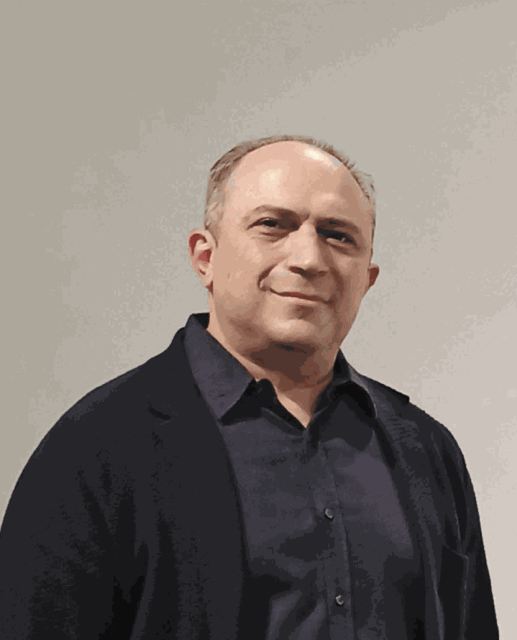Akhavanjam's mesmerising metallic sculptures comment on the relationship between abstraction and form, the constant struggle for harmony, and the psychological and physical battle between the mind and brute force.
His sculptures also address the wider social and environmental issues facing our planet. The prescient threats to our civilization that are a consequence of climate change and environmental destruction are a consistent force and source of inspiration in Akhavanjam's work.
In the artist's opinion, it is the very foundations of consumerism, wealth creation and the never-ending competition between companies and nations in terms of hedonistic economic growth that must be restructured for the sake of future generations.
As a sculptor, Akhavanjam's expertise in the material properties of polished stainless steel and bronze come to the fore in his artistic practice. His passion for the materiality of the metals he works with, particularly stainless steel, started early in life when he managed the R&D Department of his father's manufacturing company for household appliances. Akhavanjam established his workshop and has been producing sculptures since 2011.
His works have been exhibited widely in Iran and the UAE as wells as at Palazzo Bembo, Palazzo Mora and the Giardini della Marinaressa in the context of the Venice Biennale in 2017, 2019, and 2022. Recent exhibitions in the UK include 2021 ANTHEM, Tremenheere Sculpture Gardens, Cornwall, Cotswold Sculpture Park, Cirencester, 2022 Doddington Hall, Lincolnshire and Carden Park, Cheshire.
MASOUD AKHAVANJAM talks to Luli Gibbs
LG: Your early life was spent in Tehran, yet you spent much of your teenage years in Marburg, Germany - how did this cross-cultural experience shape your early life and approach to artistic production?
MA: Well, in Marburg every year we had a "practical" week in which we were able to choose among a variety of skilled, expeditionary, and musical courses. Among them, we were offered a sculpting course with ceramics, which at the age of 15 appealed to me. So, it became my expensive hobby as I spent most of my pocket money making little ceramic sculptures from that point on. I must say that every now and then I did sell a few here and there.
LG: How wonderful - so this was a passion that was birthed early on at school. I want to hear more about your experiences working with your father at his manufacturing company at the start of your career, and how working with metals and functional materials impacted your practice.
MA: My father has a very modern manufacturing company where for a few years I was the head of the R&D. It was here that I designed tens of uniquely designed products such as a gas hob in the shape of a tennis racket. In addition, I became specialised in sheet-metal-processing and, generally speaking, forming metals.
LG: A gas hob in the shape of a tennis racket sounds fascinating. You say that you have always been keenly interested in sculpture - what is it about the three-dimensional form that sparked your life-long passion?
MA: For me, I like to conceive form. I love to make things. To me a large three-dimensional form radiates a very strong and special power. When I create and after the fact, I very much feel this power which motivates me and gives me joy.
LG: Can I ask who has informed your approach to sculpture making and its distinctive appearance?
MA: Again, since I loved owning sculptures, I tried to buy as many as I could. Unfortunately, I could only find around ten pieces that I liked, none of which were the sizes that I preferred. Well, at one point I figured with the passion I have to own sculptures, and with the desire I have to conceive, why should I not create my own works of art? In addition, I looked at my sculpture as my voice to express my opinion to the world after having so many educational and personal experiences.
LG: Your works stand as political and social commentary in a world that faces many prescient threats to its existence - can you talk about how issues such as the climate crisis intersect with your work.
MA: Well, I too try to have a small voice in this very noisy world with regard to issues facing all humans. Perhaps I can reach a few influential people and get my personal message across that what we are praising and giving credit to today may not be in the interest of future generations. In fact, the actions and policies of all people and nations should be thinking in decades and centuries ahead. We are already advised not to walk outdoor in many areas of the world because of pollution. I think the environmental disaster has already reached us. Someone should have written about upcoming environmental disasters a century ago.
LG: As a follow up question, as long as these issues persist, in the future where do you see your artistic practice taking you - perhaps in terms of subject matter, thematic approach, scale?
MA: I think my subject matter will stay on the same path. I will be considering everyday social and environmental issues. As for the scale, well I may reconsider the sizes of my works and the material, as the costs and expenses are really being felt.
LG: What are your future plans in terms of exhibiting and creating?
MA: I work every day on my new ideas and new forms and am certainly planning to expand my exhibitions in Europe.
